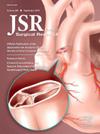急诊胃肠手术中败血症老年人营养不良的关系:一项修正的营养不良分析全球领导倡议
IF 1.8
3区 医学
Q2 SURGERY
引用次数: 0
摘要
老年人营养不良对手术结果有重要影响。在紧急胃肠手术(EGS)中,营养不良的发生率高达30%。本研究旨在探讨营养不良与术前脓毒症老年人行EGS的预后的相关性。方法纳入年龄≥65岁的术前脓毒症患者。全球营养不良领导倡议(GLIM)提出了诊断营养不良的标准。我们使用了一个改良的GLIM (mGLIM),该GLIM使用了国家外科质量改进项目数据库。mGLIM包括(1)年龄≤70岁的体重指数≤20kg /m2,年龄≥71岁的体重指数≤22kg /m2,(2)过去6个月内体重减轻10%,(3)入院白蛋白≤3.5 g/dL,(4)作为急性疾病标志物的EGS。多变量回归探讨营养不良与死亡率、住院时间和并发症的关系。结果共纳入26801例患者。人口统计学上,女性患者占58% (n = 15501)。非裔美国患者占8.0% (n = 2133),高加索患者占75.7% (n = 20,295)。小肠病例占32.1% (n = 8609),结肠直肠病例占76.5% (n = 20490)。营养不良患者占所有患者的1.8% (n = 481)。多因素回归显示,营养不良患者小肠(P = 0.001,可信区间[CI] 1.31-2.69)和结肠(P <;0.001, CI 1.47-2.39),结直肠病例并发症的可能性更高(P = 0.001, CI 1.31-2.65)。结论sour分析显示,mGLIM诊断的营养不良与EGS术后较高的死亡率和并发症发生率相关。mGLIM标准可作为营养不良风险患者不良预后的预测工具。本文章由计算机程序翻译,如有差异,请以英文原文为准。
Relation of Malnutrition on Septic Older Adults in Emergency Gastrointestinal Surgery: A Modified Global Leadership Initiative on Malnutrition Analysis
Introduction
Malnutrition in older adults has significant ramifications for surgical outcomes. The incidence of malnutrition is up to 30% in emergent gastrointestinal surgery (EGS). This study aims to investigate malnutrition's correlation on outcomes of older adults with preoperative sepsis undergoing EGS.
Methods
Adults aged ≥ 65 y who had preoperative sepsis were included. The Global Leadership Initiative on Malnutrition (GLIM) introduced criteria to diagnose malnutrition. We used a modified GLIM (mGLIM) using the National Surgical Quality Improvement Project database. The mGLIM includes (1) body mass index ≤ 20 kg/m2 for age ≤ 70 y and body mass index ≤ 22 kg/m2 for age ≥ 71 y, (2) weight loss >10% within the past 6 mo, (3) admission albumin ≤ 3.5 g/dL, and (4) EGS as an acute disease marker. Multivariate regression explored the relationship of malnutrition on mortality, length of stay, and complications.
Results
A total of 26,801 patients were included. Demographically, female patients included 58% (n = 15,501). African American patients consisted of 8.0% (n = 2133), and Caucasian patients accounted for 75.7% (n = 20,295) of the study population. Small bowel cases were 32.1% (n = 8609), and colorectal cases represented 76.5% (n = 20,490) of all cases. Malnourished patients made up of 1.8% (n = 481) of all patients. Multivariate regression revealed malnourished patients have higher chance of mortality for small bowel (P = 0.001, confidence interval [CI] 1.31-2.69) and colorectal (P < 0.001, CI 1.47-2.39) procedures, and higher likelihood of complications for colorectal (P = 0.001, CI 1.31-2.65) cases.
Conclusions
Our analysis shows that malnutrition, as identified by mGLIM criteria, is associated with higher mortality and complication rates after EGS. The mGLIM criteria could be a prognostic tool for adverse outcomes in malnutrition-risk patients.
求助全文
通过发布文献求助,成功后即可免费获取论文全文。
去求助
来源期刊
CiteScore
3.90
自引率
4.50%
发文量
627
审稿时长
138 days
期刊介绍:
The Journal of Surgical Research: Clinical and Laboratory Investigation publishes original articles concerned with clinical and laboratory investigations relevant to surgical practice and teaching. The journal emphasizes reports of clinical investigations or fundamental research bearing directly on surgical management that will be of general interest to a broad range of surgeons and surgical researchers. The articles presented need not have been the products of surgeons or of surgical laboratories.
The Journal of Surgical Research also features review articles and special articles relating to educational, research, or social issues of interest to the academic surgical community.

 求助内容:
求助内容: 应助结果提醒方式:
应助结果提醒方式:


